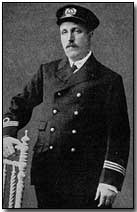Primary Documents - German Government Statement on the Execution of Captain Fryatt, 28 July 1916
 On 28 March 1915 Captain
Charles Fryatt, a British merchant captain, attempted - but failed - to ram
and sink a German submarine, U-33. This came in the wake of
repeated attempts by the German navy to sink his vessel - the Great Eastern
Railway Steamer Brussels sailing the Rotterdam/British east coast
route.
On 28 March 1915 Captain
Charles Fryatt, a British merchant captain, attempted - but failed - to ram
and sink a German submarine, U-33. This came in the wake of
repeated attempts by the German navy to sink his vessel - the Great Eastern
Railway Steamer Brussels sailing the Rotterdam/British east coast
route.
Hailed by the Allied nations as a hero - it was variously believed that he had succeeded in his patriotic act, Fryatt was officially rewarded by the British government for his actions.
Fryatt was however taken prisoner by the Germans on a subsequent voyage and charged with being a franc-tireur - a most serious charge and one that carried the death sentence. So began a war of words between the German and British governments over his case. Britain argued that Fryatt had been acting in self-defence, while Germany maintained that Fryatt's action in attempting to ram U-33 was undertaken without provocation.
In the event Fryatt was tried and convicted by a German court and executed on 27 July 1916. The case achieved widespread notoriety in Britain and Captain Fryatt's name - and face, in newspapers, magazines and even bookmarks - was celebrated throughout Britain.
Reproduced below is the official statement of the German government on the day following Fryatt's execution.
Click here to read the response written by former British Prime Minister Arthur Balfour. Click here to read the official British government statement on the matter. Click here to read Germany's reply.
Official German Government Statement, 28 July 1916
The accused was condemned to death because, although he was not a member of a combatant force, he made an attempt on the afternoon of March 20, 1915, to ram the German submarine U-33 near the Maas lightship.
The accused, as well as the first officer and the chief engineer of the steamer, received at the time from the British Admiralty a gold watch as a reward of his brave conduct on that occasion, and his action was mentioned with praise in the House of Commons.
On the occasion in question, disregarding the U-boat's signal to stop and show his national flag, he turned at a critical moment at high speed on the submarine, which escaped the steamer by a few metres only by immediately diving. He confessed that in so doing he had acted in accordance with the instructions of the Admiralty.
One of the many nefarious franc-tireur proceedings of the British merchant marine against our war vessels has thus found a belated but merited expiation.
Source: Source Records of the Great War, Vol. IV, ed. Charles F. Horne, National Alumni 1923
A "lazy liz" was a heavy artillery shell fired by the Allied battleship Queen Elizabeth.
- Did you know?
